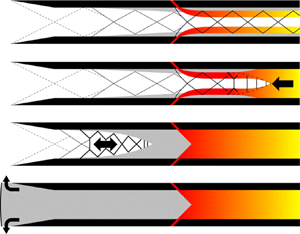Article contents
Isolator-combustor interactions in a circular model scramjet with thermal and non-thermal choking-induced unstart
Published online by Cambridge University Press: 29 April 2021
Abstract

This study investigates the interactions between combustor and isolator and the role played by combustion on choking-induced unstart. Shock train unsteadiness and pressure fluctuations in non-reacting environments have been previously explained in terms of shock-boundary layer interaction and acoustic forcing but, when applied to scramjets, it is still unclear whether and how this picture is altered by combustion effects. The novel experimental set-up used in this study consists of a circular cross-section model scramjet, with optically accessible combustor and isolator, tested in a high-enthalpy hypersonic free stream at Mach 4.5. A comparison is made between cases in which flow choking is induced via thermal (combustion) and non-thermal (mass addition) mechanisms using time-resolved static wall pressure measurements, high-speed flow visualization and planar laser-induced fluorescence of the OH radical as diagnostic tools. Further details on the nature of the interactions observed were provided by experiments performed in a low-enthalpy  $\textrm {CO}_2$ free stream at Mach 4 using planar laser scattering visualization. The results revealed remarkable qualitative similarities between unstart processes occurring at high and low enthalpy. At high enthalpy the similarities between thermal and non-thermal choking-induced unstart were both qualitative and quantitative, suggesting very limited effect of combustion on the dynamics of the isolator shock train. Isolator flow unsteadiness, on the other hand, drastically affected the propagation of the pseudo-normal shock in the combustor, but no significant feedback effect on the isolator behaviour was observed.
$\textrm {CO}_2$ free stream at Mach 4 using planar laser scattering visualization. The results revealed remarkable qualitative similarities between unstart processes occurring at high and low enthalpy. At high enthalpy the similarities between thermal and non-thermal choking-induced unstart were both qualitative and quantitative, suggesting very limited effect of combustion on the dynamics of the isolator shock train. Isolator flow unsteadiness, on the other hand, drastically affected the propagation of the pseudo-normal shock in the combustor, but no significant feedback effect on the isolator behaviour was observed.
- Type
- JFM Papers
- Information
- Copyright
- © The Author(s), 2021. Published by Cambridge University Press
References
REFERENCES
- 41
- Cited by



